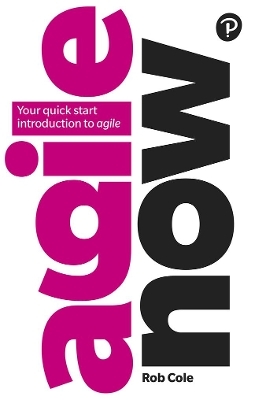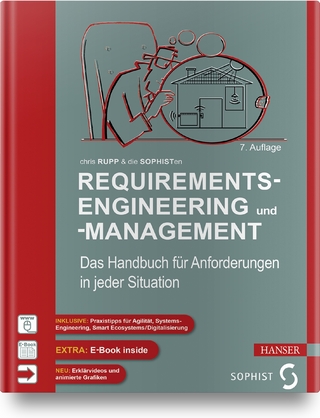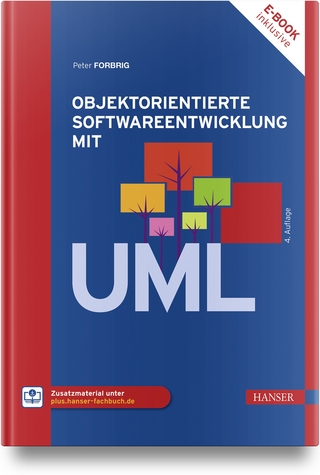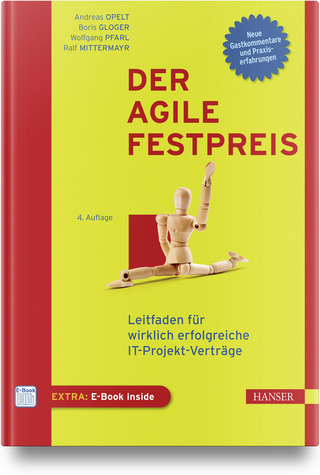
Agile Now
Pearson Business (Verlag)
978-1-292-23200-3 (ISBN)
Agile is an innovative way of working that will help you deliver high quality products and services cost-effectively, to embrace change and keep improving as you go. Whether you’re a one-person start-up or with a multinational, Agile Now will help you get to grips with the essence of agile thinking, identify what works best, avoid common mistakes and boost your efficiency.
Agile Now is a quick-start introduction with universal appeal, bringing together all the essential theory with practical advice, so you harness the power of agile and hit the ground running.
Join the agile revolution. Get agile, now.
Rob Cole is an agile coach and author with a passion for getting the best out of individuals, teams and organisations. He has a special interest in thorny challenges, especially when there are non-negotiable constraints. Always hands-on, Rob works closely with businesses to implement innovative, best-practice based solutions and to help steer them through any choppy waters - emerging confident, fully self-sufficient and ready for the challenges ahead. Rob is also the co-author of Brilliant Project Management and Brilliant Agile Project Management, both published by Pearson Business.
Table of Contents -Introducing Agility
1 – Everything Is Agile
• What it means to be agile and why it’s a game changer.
• The phenomenal spread of agile around the business world; why agile is taking the business world by storm.
• Markets develop and customers constantly want new things; agile tools and techniques embrace change;
• Agile can be applied to everything – way beyond the popular IT and tech applications.
• Agile won't mess things up - it's not a gamble.
• The focus on working smarter, not harder and getting results fast.
• Checks are built in so it’s impossible to go wildly off track.
• Like traditional methods, agile can still fail but it fails fast and inexpensively.
• A word of warning; common misunderstanding and booby-traps with agile.
• Unsuccessful projects usually fail at the start and agile avoids the perennial problem of starting on false assumptions.
• Agile delivers results and free up time for more important stuff.
• Everyone is agile some of the time and some people are agile all the time.
• Agility is infectious.
• Agile organisations achieve more than agile project teams.
• Start small and go viral.
• There’s minimal risk and immediate results – so what is there to lose?
2 – Focus On Results
• Producing results is the only thing that matters and business value is the main driver.
• It’s essential to have a vision, to know what the end goal is and that’s what business value is measured against.
• The vision, the end goal. provides a measure of success for all individual tasks and projects.
• Don’t sweat the small stuff - individual tasks are only a means to an end.
• Measure success by results and against progress towards the end goals, not by how much graft you put in.
• A minimal investment is required to get going with agile and there’s no time like the present.
• It’s easy to start small if necessary, often that’s the best approach.
• Agile handles anything from individual tasks and personal ventures to business projects can be handled.
The Golden Triangle: Prioritising, Time Boxing and Change Management.
3 – Prioritising
• Prioritising is much more than creating a to-do list.
• It’s not an unnecessary overhead, it lays the foundation for doing the right things in the right order.
• The vision and end goals provide guiding lights.
• Define a backlog working towards the vision/end goals.
• Write up the deliverables not the activities e.g. new backlog board not go to B&Q.
• Work out the size of tasks using story pointing or t-shirt sizes.
• Get it all down but keep an eye on the minimum needed to succeed – what must be done?
• Be wary of too many bells and whistles, the nice-to-haves.
• Prioritise the backlog based on business value
Constantly review the backlog, a healthy backlog changes regularly.
• Be driven by priorities not external pressure.
• Make all outputs specific, tangible and measurable.
• Remember that saying ’No’ is always an option.
4 – Time Boxing
• Time boxing is easy to understand and even easier to use.
• Time boxing puts an end to overspending; both time and hard cash.
• Open ended tasks are a recipe for disaster.
• Be mindful of the Law of Diminishing Returns and the 80/20 Rule.
• Time box everything! No excuses.
• Plan on the basis of regular deliveries to the business. Every two weeks is a popular option.
• Allocate tight but achievable time boxes to get the best results.
• Control distractions and other time stealers.
• Stick to your guns and never tolerate overruns.
5 – Change Management
• Change is essential for survival, standing still is not a viable option.
• Change is important, not something to be curbed or penalised.
• Agile embraces change with open arms.
• Incremental deliveries are vital.
• Inspect and adapt is the agile mantra.
• A changing backlog is a healthy backlog.
• Learns from mistakes but waste time searching for scapregoats.
• Have a strategy but think now and avoid 5 year plans.
• Plan in a maximum of 12 month chunks – only worry about where you want to be next year; elements of the organisations may not always get agile but even they like annual planning.
6 – Agile Tools & Techniques
• The best of tools available featuring Scrum and Kanban.
• Overview of the tools available for managing backlogs and workflows.
• Simple agile frameworks for a light touch approach.
• Upscaling to more complex ventures and projects.
• Ways to implement meaningful and useful metrics.
• The importance of avoiding an obsession with technology and processes.
7 – Resource Management
• Agile techniques focus on effective resource management.
• People are a pivotal resource.
• Being Lean – the characteristics of agile thinking.
• What is takes to be agile, how to think act and behave.
• Getting the best out of people and teams.
• Training vs. coaching and mentoring.
• Be wary of evangelists and false prophets.
• Managing an agile transformation – remember there might well be pain!
• Getting leopards to change their spots.
• Applying agile principles at a personal level.
• Reaping the benefits of delegating and outsourcing.
• The importance of positive working relationships.
• A healthy body and mind helps promotes agility and productivity.
8 – Learning Fast
• The importance of building an open, honest learning culture.
• Mistakes are inevitable, just don’t repeat them
• Reduce waste by learning from mistakes and mitigating against disasters.
• Reap the benefits of repeating what do you do well.
• Build in continuous improvement to maximize productivity.
• A practical guide to looking back and learning, formats for retrospectives and lessons learned sessions.
• Common mistakes and traps to avoid.
| Erscheinungsdatum | 26.06.2020 |
|---|---|
| Verlagsort | Harlow |
| Sprache | englisch |
| Maße | 137 x 213 mm |
| Gewicht | 200 g |
| Themenwelt | Sachbuch/Ratgeber ► Beruf / Finanzen / Recht / Wirtschaft ► Bewerbung / Karriere |
| Informatik ► Software Entwicklung ► Agile Software Entwicklung | |
| Wirtschaft ► Betriebswirtschaft / Management ► Projektmanagement | |
| ISBN-10 | 1-292-23200-5 / 1292232005 |
| ISBN-13 | 978-1-292-23200-3 / 9781292232003 |
| Zustand | Neuware |
| Haben Sie eine Frage zum Produkt? |
aus dem Bereich


